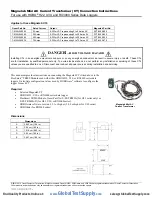
37
DATA COMMUNICATIONS
RADIO TELETYPE (RTTY)
RTTY is the data communications mode with the
longest history. It was originally designed for use with
mechanical teletypewriters which were often used
before personal computers became common. Now
you can easily start operating RTTY with a personal
computer and MCP. Unlike Packet, each time you
type a letter, it is transmitted over the air. What you
type is transmitted and displayed on the computer
screen of the recipient.
RTTY operation uses frequency shift keying (FSK)
and the 5-bit Baudot code or the 7-bit ASCII code to
transmit information.
For cable connections, refer to “RTTY OPERATION”
{page 68}.
For further information, consult reference books about
Amateur Radio.
1
Access Menu No. 44 and select an FSK shift.
• FSK shift is the difference in frequencies
between a mark and a space.
• The 170 Hz shift (default) is normally used on
the Amateur bands for the RTTY.
2
Access Menu No. 45 and select a key-down
polarity.
• Select “oFF” (default) to transmit a mark when
keying down or “on” to transmit a space.
3
Access Menu No. 46 and select “2125” (high tone)
or “1275” (low tone) for mark.
• High tone (default) is commonly used
nowadays.
4
Select an operating frequency.
5
Press
[CW/FSK (REV)]
to select FSK mode.
• “FSK”
appears.
• If necessary, access Menu No. 67 to configure
the appropriate audio output level for your
MCP. The audio output level of ANO (
ACC2
connector/ pin 3) changes {page 65}. The
AF
control cannot be used to adjust the audio level
for your MCP.
6
Some stations may be operating in Reverse shift.
In this case, press and hold
[CW/FSK (REV)]
to
reverse the shift (the upper sideband is used).
• “FSR”
appears.
• Traditionally, the lower sideband is used for
FSK operation. Press and hold
[CW/FSK
(REV)]
again to return to the lower sideband.
“FSK” appears.
7
Follow the instructions provided with your MCP
and enter a command from your computer to
transmit.
• The TX-RX LED changes from green (RX) to
red (TX).
8
Begin sending data from your computer.
• Press and hold
[PWR (TX MONI)]
to monitor
your signals. Press and hold
[PWR (TX MONI)]
again to quit this function.
9
When finished transmitting, enter a command from
your computer to return to reception mode.
• The TX-RX LED changes from red (TX) to
green (RX).
The following frequencies (measured in kHz) are
commonly used for RTTY operation:
U.S.A./ Canada
IARU Region 1
(Europe/ Africa)
1800 ~ 1840
1838 ~ 1842
3605 ~ 3645 (DX: 3590)
3580 ~ 3620
7080 ~ 7100 (DX: 7040)
7035 ~ 7045
10140 ~ 10150
10140 ~ 10150
14070 ~ 14099.5
14080 ~ 14099.5
18100 ~ 18110
18101 ~ 18109
21070 ~ 21100
21080 ~ 21120
24920 ~ 24930
22920 ~ 24929
28070 ~ 28150
28050 ~ 28150
PHASE-SHIFT KEYING 31 BAUD (PSK31)
PSK31 is a digital modulation method used in
amateur radio communications. You can perform data
communications in real-time using a keyboard, like
RTTY. Additionally, because of the narrow bandwidth
(31.25 Hz) you can even use PSK31 on congested
frequencies. Another merit to PSK31 is that it can
be enjoyed with a simple antenna and low transmit
power.
Using the sound function of your PC along with
PSK31 software, many amateur radio operators enjoy
PSK31.
• Refer to “TNC AND MCP” {page 69} for
connections.
• When managing PSK31 using the sound capability
of a PC, use SSB mode.
• Set AGC to fast.
• Turn off the speech processor.
• Refer to “EXTERNAL AUDIO SETTINGS”
{page 58} for Audio Settings.
For further information, consult reference books about
Amateur Radio.
















































